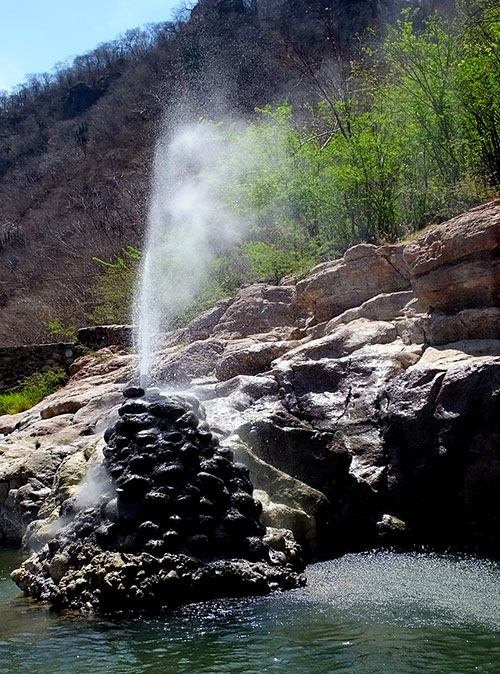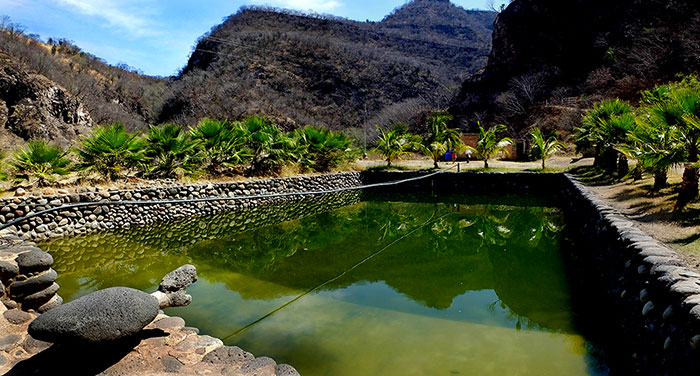|
By John Pint
 A
75-minute drive north of bustling Guadalajara can bring you to a
charming oasis bubbling with thermal activity. My first visit to this
extraordinary place on the Patitos (Little Ducks) River, many years
ago, is impossible for me to forget. I had been lured into the San
Cristóbal Canyon by botanist Miguel Cházaro who had promised to take me
to “a cold river heated by a ‘singing’ underwater geyser located in the
middle of it.” Naturally, Cházaro first led me off to non-thermal parts
of that same, very long, river, to help him search for a succulent
called Echeveria, which he needed for his collection. This botanical
mission somehow ended up taking most of the day and the sun was about
to set when we finally parked near the hot springs. Cházaro lost no
time. Under his pants he was already wearing his swimming trunks. In a
flash he had removed the pants, jumped out of the car and was running
toward the river. He waded to the middle and shouted, “ˇAquí está! Here
it is! The singing geyser!” A
75-minute drive north of bustling Guadalajara can bring you to a
charming oasis bubbling with thermal activity. My first visit to this
extraordinary place on the Patitos (Little Ducks) River, many years
ago, is impossible for me to forget. I had been lured into the San
Cristóbal Canyon by botanist Miguel Cházaro who had promised to take me
to “a cold river heated by a ‘singing’ underwater geyser located in the
middle of it.” Naturally, Cházaro first led me off to non-thermal parts
of that same, very long, river, to help him search for a succulent
called Echeveria, which he needed for his collection. This botanical
mission somehow ended up taking most of the day and the sun was about
to set when we finally parked near the hot springs. Cházaro lost no
time. Under his pants he was already wearing his swimming trunks. In a
flash he had removed the pants, jumped out of the car and was running
toward the river. He waded to the middle and shouted, “ˇAquí está! Here
it is! The singing geyser!”
And it was truly singing, or sort of
wailing! And there I was, rummaging in my knapsack for my swim suit,
when the driver of my car announced, “Sorry, folks, we only have a few
minutes of daylight left to find our way back to the highway. We have
to leave right now!”
So I never had a chance to enjoy the
hot-and-cold river experience nor did I suspect that there were
numerous geysers sputtering away only a hundred meters from that spot…
...Until
four days ago when, on FaceBook, I saw a video of gorgeous geysers on
the Cuixtla River north of San Cristóbal de las Barrancas. “That is the
Patitos River,” I said to myself, “and this time I’m going to get into
it.”
Without a problem I found five friends ready to drop
everything and yesterday we headed north along the road from Tesistán
to San Cristóbal.
This is now a divided highway, offering a
magnificent view of a magnificent canyon and it conveniently skirts the
town of San Cristóbal, in a few minutes bringing us to a turnoff
signposted Ixcamilpa. What previously was a dirt road is now nicely
paved and in only 20 minutes we arrived at our destination, which
Google Maps calls “Campamento Huitztlán.” Here we found a big garden
dotted with curious rock sculptures and lined with nice shade trees.
Under one of them stood the owner of the place, Roberto Castro, who
told me that his little paradise is called Parque Ecológico Los
Hervores, “no matter what Mr. Google might call it.” He also referred
to the river as the Cuixtla and the nearest pueblo as Atistique, even
though I could find neither name on the maps I checked.
Don
Roberto, we learned, has been working on his thermal park for six
years. “In the past people knew about this place,” he told us. “They
knew it was special, but it was very difficult to get here and once
they arrived, it was all rough and rocky, with no shade of any kind. So
I bought this land and tried to turn it into a park. I brought in dirt,
planted trees and I constructed that wall over there to stop the river
from washing everything away during the rainy season. And while working
on the wall I uncovered several new geysers. Bueno, I was on FaceBook
at that time and I saw how people were posting anything there, even a
plate of enchiladas, so I started uploading videos of these geysers and
that drew a lot of attention to this place...people started coming on
the weekends.”
As he spoke, my eye wandered to the curious stone
statues all around us. There was a bird here, a crocodile there, a
voluptuous goddess of sorts and even a motorcycle worthy of Fred
Flintstone.
“As for the sculptures,” continued Don Roberto, “I
worked as a landscaper in Palm Springs, in the USA and I learned that
little touches could transform a garden into something beautiful. At
the same time, I made my statues safe, so they can’t hurt anyone. You
can jump all over them if you like.”
We then took a tour of the
place, starting with three swimming pools fed by hot springs. “Pick the
one with the temperature you prefer,” said Don Roberto. All the pools
were coated with green algae, but the water was perfectly clean and
constantly circulating.

The
biggest pool at Parque Ecológico Los
Hervores
We walked only 280
meters to the
riverside where geysers seemed to be hissing everywhere. Eventually we
came to a natural “hot pot” where guests like to boil eggs. The water
temperature was 80 degrees Centigrade (176 Fahrenheit).
Don Roberto
made the mistake of mentioning that there was a cave nearby. This
resulted in a delightful 800 meter hike through beautiful woods and
dramatic arroyos. The cave turned out to be a long fissure where we
spotted a few vampire bats. We also saw several strangler figs clinging
to sheer rock walls as well as a stone wall which Don Roberto said had
been constructed in preHispanic times. Birdwatcher Chris Lloyd spotted
15 birds that afternoon, including a motmot, a Mexican trogon (pájaro
bandera) and a common black hawk. The hike put us in the mood for a
soak in the “nearly body temperature” pool which, later, no one wanted
to leave when it was time for us to go back home.
As this
charming oasis can see up to 100 visitors on a weekend, I suggest you
come on a weekday. Just about any kind of car can easily reach the
place. From Monday to Friday the cost is 50 pesos per vehicle. Don
Roberto sells cold beer and refrescos, but not food and, yes, overnight
camping is allowed. Don Roberto’s Cell is 333 451 0423 and he speaks a
little English. At the moment, this is the only geyser park I know of
in all Jalisco, so don’t miss it!
How
to get there
Take the
western Periférico north to the Tesistán road. Exit the Periférico and
drive northwest 8 kilometers to highway 23 heading for Colotlán. Drive
40 kilometers north, skirting the town of San Cristóbal. At N21.07634
W103.42088 you will see a sign saying Ixcamilpa. Turn left and follow
the paved road nine kilometers to the geyser park (N21.11326
W103.44525). Google Maps will get you there from anywhere if you aim at
Campamento Huixtlán, even though this is a totally wrong name for the
Parque Ecológico… but that’s Mexico! Driving time from the Periférico:
about one hour and 15 minutes.
|

